
Fynbos is a small belt of natural shrubland or heathland vegetation located in the Western Cape and Eastern Cape provinces of South Africa. This area is predominantly coastal and mountainous, with a Mediterranean climate and rainy winters. The fynbos ecoregion is within the Mediterranean forests, woodlands, and scrub biome. In fields related to biogeography, fynbos is known for its exceptional degree of biodiversity and endemism, consisting of about 80% species of the Cape floral kingdom, where nearly 6,000 of them are endemic. This land continues to face severe human-caused threats, but due to the many economic uses of the fynbos, conservation efforts are being made to help restore it.

The Lymantriinae are a subfamily of moths of the family Erebidae. The taxon was erected by George Hampson in 1893.
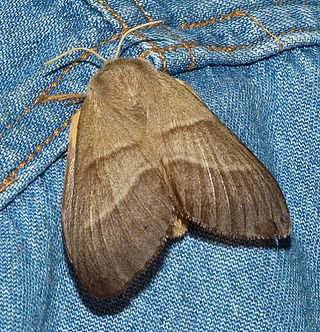
The Lasiocampinae are a subfamily of the moth family Lasiocampidae. The subfamily was described by Thaddeus William Harris in 1841.
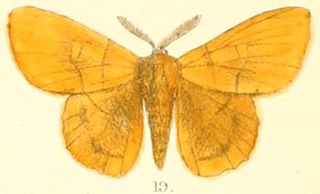
Crinocraspeda is a monotypic moth genus in the family Lasiocampidae erected by George Hampson in 1893. Its only species, Crinocraspeda torrida, was described by Frederic Moore in 1879.

Streblote is a genus of moths in the family Lasiocampidae. It was described by Jacob Hübner in 1820.
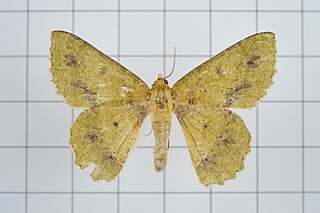
Herochroma cristata is a species of moth of the family Geometridae first described by William Warren in 1905. It is found in China, Taiwan, north-eastern India, Bhutan, Nepal, Thailand, northern Vietnam and Indonesia.
The Diep River Fynbos Corridor is a nature reserve located in the Blaauwberg region of Cape Town, South Africa. It forms part of the larger Table Bay Nature Reserve, which was established in June 2012.
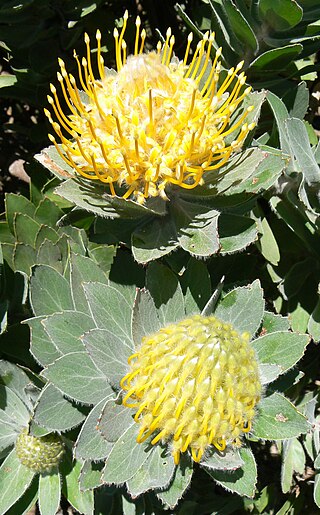
Peninsula Granite Fynbos is an endangered Fynbos vegetation type which is endemic to the city of Cape Town and occurs nowhere else. It is a unique type of tall, dense and diverse scrubland, scattered with trees. It can be found all along the belt of granite that encircles Table Mountain.

Porela vitulina is a moth of the family Lasiocampidae. It is known from Australia, including New South Wales, Queensland and Victoria.
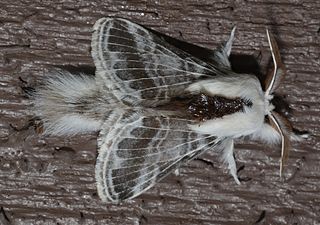
Tolype velleda, the large tolype moth or velleda lappet moth, is a species of moth of the family Lasiocampidae. It was first described by Caspar Stoll in 1791. The species is found from Nova Scotia to central Florida, west to Texas and north to Ontario. Also found in the California Mountains. Out of the United States, they can also be found in low and littoral areas of the Iberian Peninsula and North Africa from Egypt to the Atlantic coast of Morocco.

Cecilia is a section of the Table Mountain National Park on the lower eastern slopes of Table Mountain in Cape Town, located just to the south of Kirstenbosch National Botanical Garden. It was previously used for commercial logging and known as Cecilia Forest or Cecilia Plantation, but has now been given protected status and integrated into the National Park.

Eucraera koellikerii is a species of Lasiocampidae moth, it is known from Angola, Congo, Equatorial Guinea, Kenya, Mozambique, South Africa and Tanzania.
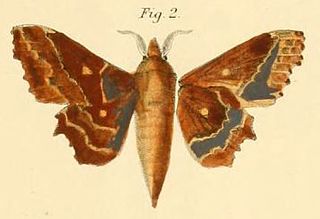
Mimopacha knoblauchii is a species of Lasiocampidae moth.

Streblote polydora is a moth of the family Lasiocampidae first described by Herbert Druce in 1887. It is found in Angola, the Democratic Republic of the Congo, Eritrea, Mozambique, South Africa, Tanzania and Zimbabwe.

Streblote diluta is a species of moth in the family Lasiocampidae first described by Per Olof Christopher Aurivillius in 1905.
Streblote dorsalis is a moth of the family Lasiocampidae first described by Francis Walker in 1866. It is found in India, Sri Lanka, the Philippines, Borneo, Indonesia and Java.

Streblote panda is a moth of the family Lasiocampidae.

Streblote siva, the jujube lappet moth, is a medium-sized moth, a widespread Arabic species. It has been documented in the UAE, Bahrain, and Qatar. The species was introduced to Iran. It belongs to the family Lasiocampidae. The species was first described by Lefèbvre in 1827. The species primarily consumes plants of the genus Ziziphus as well as Acacias.

Odonestis pruni, also known as the plum lappet moth or the plum eggar, is a species of moth, belonging to the family Lasiocampidae. It was first described by Carl Linnaeus in 1758. It is native to Eurasia.


















